Last Updated on December 3, 2025 by Maged kamel
Solved problem 10-1- Moment Values By Three-Moment Equations For Continuous Beam-3/4.
For our solved problem 10.1, We have completed the selection of the beam section using Plastic analysis and will proceed with an elastic design using the 0.90 rule.

Brief description of the 0.90 rule for the elastic redistribution of the moment.
Utilizing the three-moment equations effectively allows for a better understanding of continuous beams.
Part b of the requirement is to design the beam using elastic analysis with the service loads and the 0.9 rule.
The 0.90 rule is a redistribution method for bending moments in which 90% of the value of the negative moment is considered. The 10% will be added to the positive moment for an intermediate span.
We add the average 10% value, the reduced value between the two supports from 0 to 10%, to the maximum positive moment for the end span.
For the case of a beam with a continuous edge, the average of 10% of the values is to be added to the maximum positive.
How to use the three-moment equations?
When applying the three-moment equations, it is essential to consider continuity in your calculations.
The three-moment equations for the fixed joint A.
In the method of three-moment equations, at the fixed support, there is an imaginary beam length L0 with a distance equal to zero, so L0=0 at the left side of support A.

From the next slide, review the equation of the three-moment equations. Since there is no moment, we apply the equation of three moments at Joint A, with no elastic reaction at the left span of Joint A.
The second beam has a concentrated load, which we call P1. Its elastic reactions can be estimated after we draw the ding moment diagram; the maximum moment = P1*L1/4.
I will not write the value of P1 or W1 until I get the final relation through matrices, at which point I will substitute these values.
The elastic reaction value is the area of half of the bending moment triangle, which is 0.50 *(P1*L/4)*L1/2=P1*L1^2/16, which is the half value of the triangle.
That was the value of the elastic reaction for the concentrated load.
But, we have a uniform load with intensity W1, which causes a bending moment = W1*L1^2/8. The elastic reaction value is the area of half of the parabola, which is=1/2*(2/3)*L2*(W1*L^2*(1/8)).
This value is the elastic reaction at the right side of joint A. The area of the half of the parabola=1/2*(2/3)*L1*(W1*L1^2/8)= W1*L1^32/24.
To solve the equation by using matrices, consider the following:
1-Put moments MA, MB, MC, and MD as a vertical column matrix (4×1).
2-While the row matrix is (1×4), from the three moments equation, the matrix can be arranged as 2*L1*MA+L1*Mb+ 0*Mc+0*MD= -6*(P1*L1^2/16) -6*(W1*L1^3/24), at the right side of the equation.
We consider a column matrix 4×1, which is the load’s column (W1 W2 W3 W4), so (-6/24)=-1/4*L1^3.The row matrix 4×1 is(-1/4*L1^3 0 0 0).
For the concentrated load matrix, it has a column vector, 4×1, as (P1 P2 P3 P4), the row matrix 4×1 which is (-3/8*L1^2 0 0 0).
This row will be multiplied by the vector matrix (W1 W2 W3 W4).
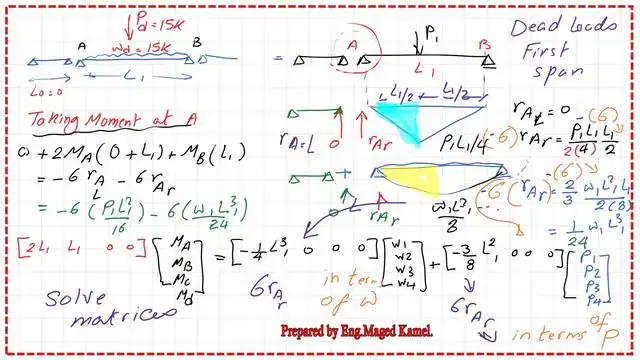
By leveraging the three-moment equations, engineers can accurately determine reaction forces at joints.
We have completed writing both sides of the matrix equation for the moment at joint A.
The three-moment equations for the continuous joint B.
From the next slide, we will write the moment’s equation at joint B for the three-moment equations.
We have two beams at B. One is located on the left side, with length=L1, and it is loaded by a uniform load W1 and a concentrated load P1.
The second beam, which is at the right side of B and has a length=L2, is loaded with a uniform load of W2.
The moment at B is written as MA*L1+2*MB*(L1+L2)+MC*(L2) =-6*r-br-6*r-bL, where r-bL is the elastic reaction at B from the left part, while r-br is the elastic reaction at b from the right part.
The elastic reaction at b from the left, r-bL=elastic reaction from the uniform load W1+ elastic reaction from the concentrated load P1, the elastic reaction at B from the right, and the r-br=elastic reaction from the uniform load W2. -6*(r-br)=-6*(W2*L2^3/24).
-6*(r-bL)=-6*W1*L1^3/24+(-6)* (P1*L1^2/16).
We will create a matrix as follows: The moment vector matrix is a vector matrix ( MA MB MC MD).
From the three moments equations, we have a row matrix 1×4,(L1 2(L1+L2) L2 0) to be multiplied by ( MA MB MC MD).
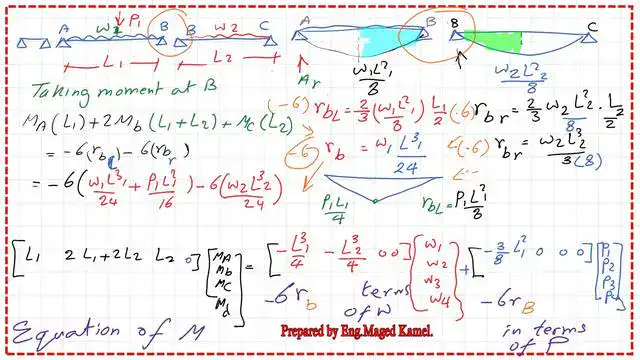
The Elastic reaction related to W1, W2, W3, W4, can be represented as a row matrix, 1x 4, as shown, (-L13^3/4 -L2^3/4 0 0).
While for the column matri,x due to concentrated loads being 4×1, (P1 P2 P3 P4), we have a row-column 4x,1 which is (-3/8*L1^2 0 0 0 ).
The three-moment equations for the continuous joint C.
From the next slide, the moment at joint C can be represented by the two beams intersecting at C.
The second beam is loaded by W2, with span =L2, while the third beam has a load of W3 with span =L3.The three moments equations to be written as MB*L2+2*MC*(L2+L3)+MD*0= -6r-cL-6*r-cr= -1/4*W2*L2^3-1/4*W3*L3^3. We have a row matrix 1×4 which is (0 L2+2*(L2+L3) 0), and a vertical matrix, MA MB MC MD), For the row matrix 4×1,(0 -L2^3/4 -L3^3/4 0), and a column matrix (W1 W2 W3 W4).
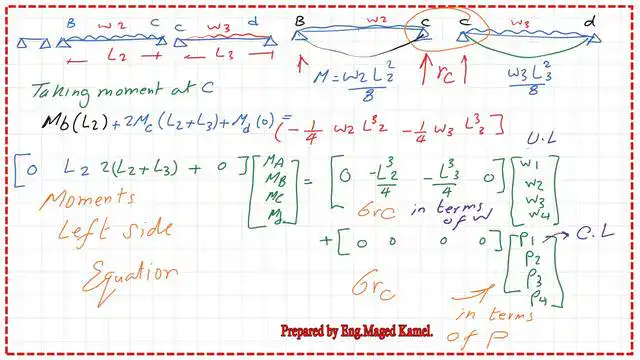
We do not have any elastic reaction values from the concentrated loads, which can be represented by the row matrix 1×4, (0 0 0 0) and a column matrix (P1 P2 P3 P4).
The three-moment equations for the end joint D.
From the next slide, three-moment equations.
We are left with the moment at joint D. The elastic reaction at D=0, the moment at D=0, since joint D supports. The row matrix 4×1,(0 0 0 0) and a column matrix (W1 W2 W3 W4) Plus the row matrix 4×1,(0 0 0 0) and a column matrix (P1 P2 P3 P4). This matrix is written to suit the condition when the last support is a hinge.
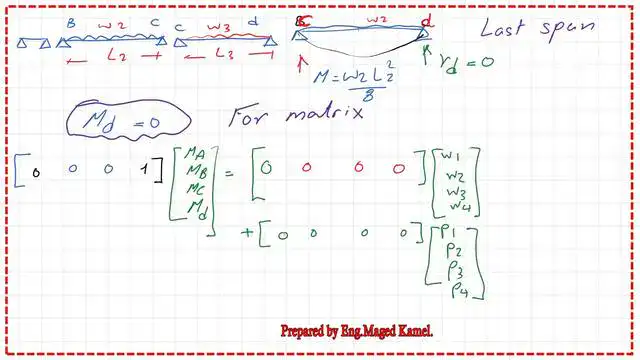
Understanding the principles behind three-moment equations is crucial for accurate structural analysis.
The final form matrix equations for the continuous beams.
We have a matrix 4×4 multiplied by a column vector (MA MB MC MD) plus that matrix 4×4 has the data related to the span lengths. While at the right-hand side, we have the coefficient of elastic reactions 4×4, multiplied by the column vector (W1 W2 W3 W4) plus the coefficient of elastic reactions 4×4, P3 P4).
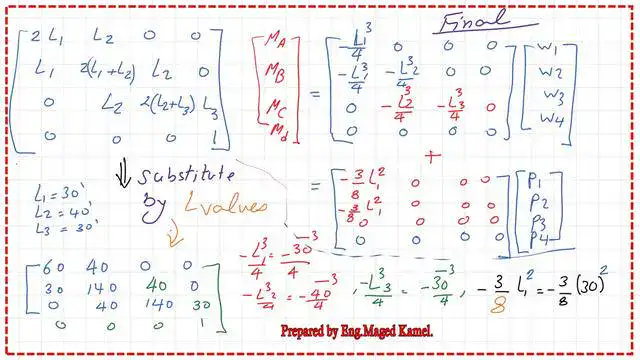
In the next post, we will find out the final values of moments.
Have more information about the structural analysis –III.